Linen thread counts - what's the difference?
My in-box has had quite a few emails lately asking about linen for embroidery so, dear readers, when you ask I shall endeavor to answer!Firstly, I should explain that the way the linen is labeled is NOT the same in the USA as it is in Europe. And, boy oh boy, did that confuse me when I started looking for linen here. 28 count linen? Nope, don't have it. We do, however, have 10cm Cashel linen by Zweigert. Hmmmm...I wasn't sure that's what I wanted. Guess what? It's the same thing!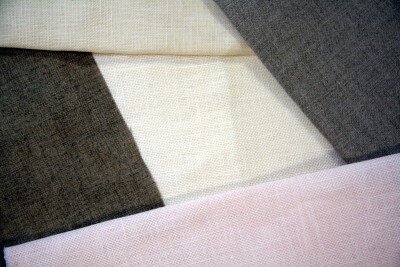 The count of the fabric refers to the number of threads per unit of measure. In the USA, 28 count means 28 threads per inch and in Europe 10 cm means 10 threads per centimeter. I haven't seen the term "count" or "ct." on linen fabric here, only the number followed by "cm" for centimeter. The higher the number the more threads there are per unit of measure (inch or centimeter) and the finer weave. This is why I chose 28 count/10 cm linen for my blackwork project - anything with a higher count would have blinded me!I've taken photos of 6 different linens, with a tape measure in the photo, so you can see first hand the differences between the fabrics. For those of us who must order most or all of our supplies online, I hope these photos help.This first photo is of a 16 cm linen ordered from France. I ordered it online from the shop La Couserie Creative. This linen in really quite extraordinary. The weave is just about perfectly even - almost no slubs (slubs are those thick bits of fiber in the weave of the fabric that clearly don't belong). Even after pre-washing, it's quite stiff. It's very light and fine but still holds stitches beautifully. It's the linen I'm using for the embroidered borders on my winter linen pillows. I love it. Absolutely love it.
The count of the fabric refers to the number of threads per unit of measure. In the USA, 28 count means 28 threads per inch and in Europe 10 cm means 10 threads per centimeter. I haven't seen the term "count" or "ct." on linen fabric here, only the number followed by "cm" for centimeter. The higher the number the more threads there are per unit of measure (inch or centimeter) and the finer weave. This is why I chose 28 count/10 cm linen for my blackwork project - anything with a higher count would have blinded me!I've taken photos of 6 different linens, with a tape measure in the photo, so you can see first hand the differences between the fabrics. For those of us who must order most or all of our supplies online, I hope these photos help.This first photo is of a 16 cm linen ordered from France. I ordered it online from the shop La Couserie Creative. This linen in really quite extraordinary. The weave is just about perfectly even - almost no slubs (slubs are those thick bits of fiber in the weave of the fabric that clearly don't belong). Even after pre-washing, it's quite stiff. It's very light and fine but still holds stitches beautifully. It's the linen I'm using for the embroidered borders on my winter linen pillows. I love it. Absolutely love it.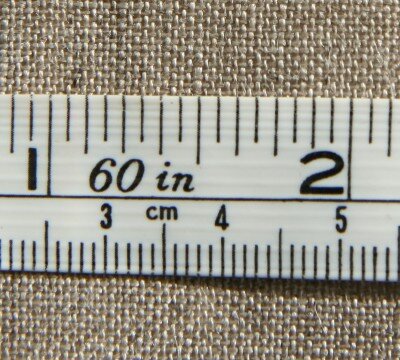 The count of the French linen is equal to the 40 count linen in the second photo below. If you look carefully, you will see that the 40 count linen below has thicker and flatter fibers. It has a much softer hand but also has more slubs - only a few but still more than the linen from Courserie Creative.
The count of the French linen is equal to the 40 count linen in the second photo below. If you look carefully, you will see that the 40 count linen below has thicker and flatter fibers. It has a much softer hand but also has more slubs - only a few but still more than the linen from Courserie Creative.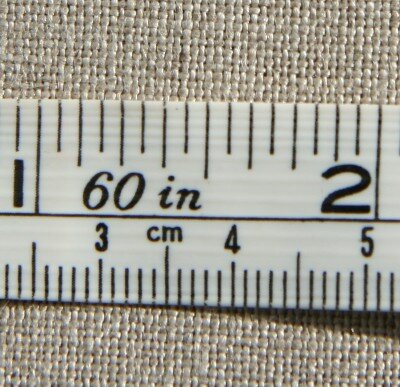 Next we come to 36 count linen in a beautiful soft creamy color.You can see that not all the fibers are of the same diameter which is typical of most linen. Just above the 1 and 3/4 inch mark on the tape measure you can see a giant slub. I quite like slubs since they remind me this is a natural fabric.
Next we come to 36 count linen in a beautiful soft creamy color.You can see that not all the fibers are of the same diameter which is typical of most linen. Just above the 1 and 3/4 inch mark on the tape measure you can see a giant slub. I quite like slubs since they remind me this is a natural fabric.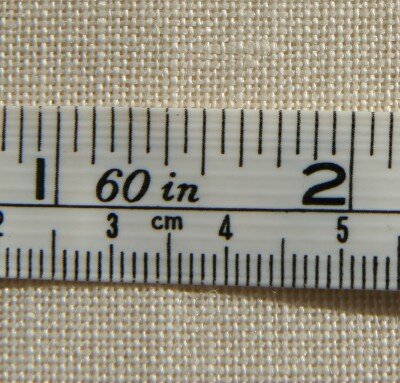 This next linen is a soft pink 32 count. Here the fibers are of a more even diameter and I assume that's because as the count of the linen gets lower, the fibers can be thicker (less threads per inch or centimeter) so getting them a uniform diameter isn't so problematic.
This next linen is a soft pink 32 count. Here the fibers are of a more even diameter and I assume that's because as the count of the linen gets lower, the fibers can be thicker (less threads per inch or centimeter) so getting them a uniform diameter isn't so problematic.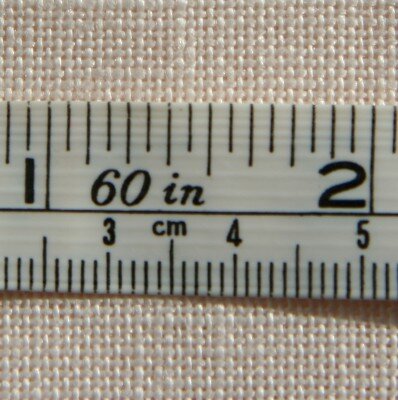 The last embroidery linen is the one I'm using for the blackwork project I'm doing now. It's from Zweigert and is a 28 count Cashel linen. This really is lovely linen and, though I usually prefer a finer weave, this is just perfect for blackwork.
The last embroidery linen is the one I'm using for the blackwork project I'm doing now. It's from Zweigert and is a 28 count Cashel linen. This really is lovely linen and, though I usually prefer a finer weave, this is just perfect for blackwork.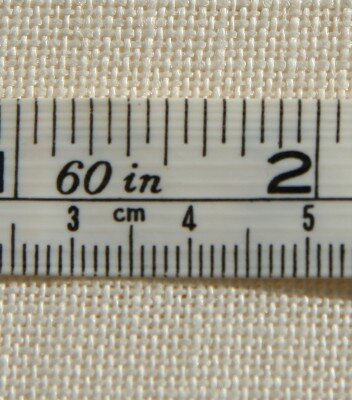 Lastly we come to sewing linen which I purchased in a fabric shop. This linen has more slubs in it that the embroidery linen but I love it because it's very soft and has a great texture. All those slubs mean that I must have a very sharp needle when I'm stitching so I can pierce the thick threads and the slubs and put the needle where I want it to be, not where the fabric pushes it to go! You can see very clearly that the weave of the linen is nowhere near as even as with previous linens. Look just below the 3cm mark on the tape measure and you will see 3 or 4 different thread thicknesses in the space of only 4 millimeters. However, that said, I quite like using this linen. For one thing, the color choices are vast. It's a bit less expensive so I can afford to get larger pieces and use it to make embroidered table runners.
Lastly we come to sewing linen which I purchased in a fabric shop. This linen has more slubs in it that the embroidery linen but I love it because it's very soft and has a great texture. All those slubs mean that I must have a very sharp needle when I'm stitching so I can pierce the thick threads and the slubs and put the needle where I want it to be, not where the fabric pushes it to go! You can see very clearly that the weave of the linen is nowhere near as even as with previous linens. Look just below the 3cm mark on the tape measure and you will see 3 or 4 different thread thicknesses in the space of only 4 millimeters. However, that said, I quite like using this linen. For one thing, the color choices are vast. It's a bit less expensive so I can afford to get larger pieces and use it to make embroidered table runners. For a great list of fabric types, count and fiber content, go to this page on the Needle in a Haystack website. Scroll down about 1/3 of the way and click on the link entitled "Industry Fabric List". If you're interested in the story of linen, Mary Corbet posted a wonderful video on Needle 'N Thread about a month ago called "Be Linen". I highly recommend you watch it!If you have any information, tips or questions about linen, why not leave a comment? We'd love to hear from you!
For a great list of fabric types, count and fiber content, go to this page on the Needle in a Haystack website. Scroll down about 1/3 of the way and click on the link entitled "Industry Fabric List". If you're interested in the story of linen, Mary Corbet posted a wonderful video on Needle 'N Thread about a month ago called "Be Linen". I highly recommend you watch it!If you have any information, tips or questions about linen, why not leave a comment? We'd love to hear from you!
